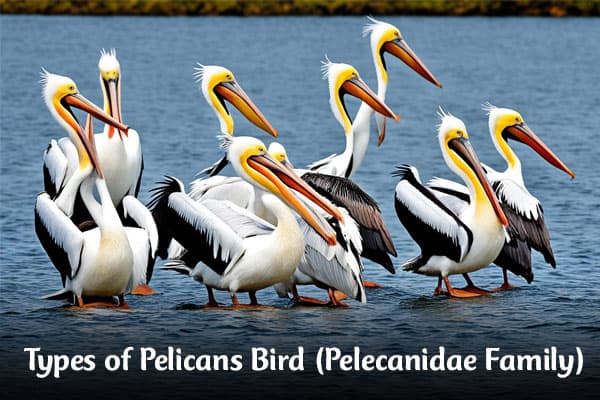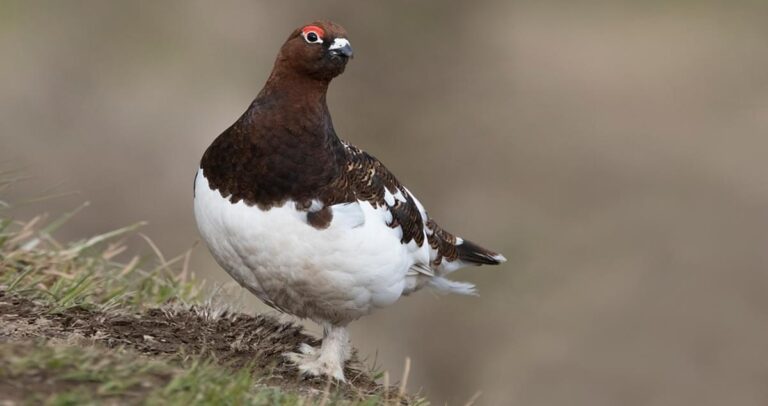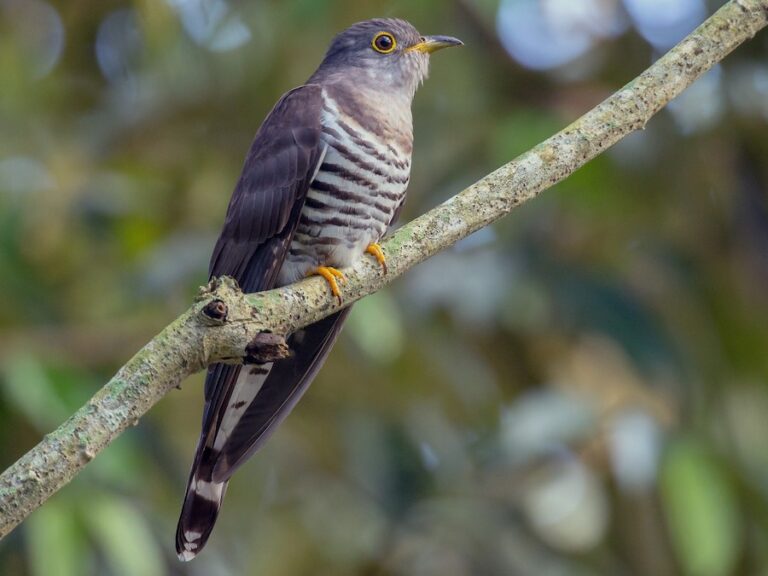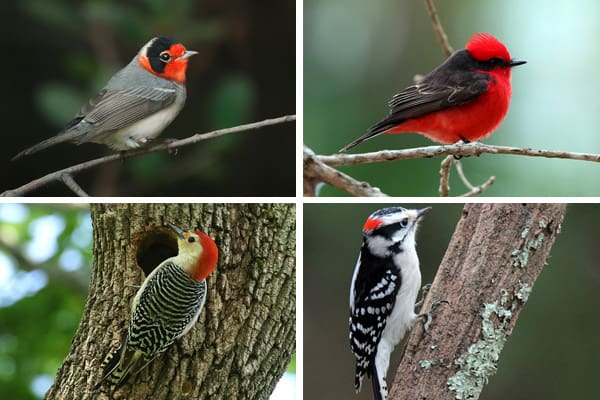8 Types of Pelicans Bird (Pelecanidae Family)
Pelicans belong to the Pelecanidae family and are known for their long beaks and big throat pouches. These features help them catch prey and drain water from their catch. There are eight living pelican species found all over the world, from the tropics to the temperate zone.
However, they are not found in the interior of Amazonian South America, the polar regions, or the open ocean. But, they can travel hundreds of miles inland in North America. They follow large waterways like the Mississippi River.
Introduction to Pelicans
Pelicans belong to the Pelecanus genus and the Pelecanidae family. They are known for their long beaks and large throat pouches. These features help them catch prey and drain water before swallowing. Let’s dive into their unique traits and behaviors.
Physical Characteristics and Behavior
Pelicans have mostly pale feathers, except for the brown and Peruvian pelicans. Before breeding, their bills, pouches, and skin turn brightly colored. They are social birds, living in large groups, hunting together, and breeding in big colonies.
The four white pelicans nest on the ground, while the four brown or grey ones nest in trees. They have a huge wingspan, up to 3 meters (10 feet), and can weigh up to 13 kg (30 pounds).
“Pelicans can have a wingspan of up to 3 meters (10 feet) and weigh up to 13 kg (30 pounds).”
Pelicans are not just beautiful; they have interesting behaviors too. They are great at soaring and dipping their beaks into the water to catch fish. This shows their amazing hunting skills.
As we learn more about pelicans, we’ll look into different types and their unique traits. Stay tuned for more interesting facts about these amazing birds!
Types of Pelicans
The Pelecanidae family has eight distinct pelican species, each with its own special traits. These birds can be split into two main groups. Four species live on the ground and have white feathers as adults. The other four live in trees or on sea rocks and have grey or brown feathers.
Let’s look at the different types of pelicans found worldwide:
- American White Pelican (Pelecanus erythrorhynchos)
- Brown Pelican (Pelecanus occidentalis)
- Peruvian Pelican (Pelecanus thagus)
- Great White Pelican (Pelecanus onocrotalus)
- Australian Pelican (Pelecanus conspicillatus)
- Pink-backed Pelican (Pelecanus rufescens)
- Dalmatian Pelican (Pelecanus crispus)
- Spot-billed Pelican (Pelecanus philippensis)
These pelicans live in warm places all over the world, except Antarctica. They are known for their big pouches. They use these to catch fish and to cool down by fanning the air.
| Pelican Species | Habitat | Unique Characteristics |
|---|---|---|
| Australian Pelican | Coastal regions and estuaries of Australia and surrounding islands | Possesses the longest bill of any known bird, measuring up to 19 inches (48 cm) |
| Spot-billed Pelican | Freshwater lakes and marshes in Southeast Asia | Classified as “near-threatened” and is one of the most endangered pelican species globally |
| Great White Pelican | Shallow lakes and swamps in Africa, Eastern Europe, and Asia | Hunts in groups of six to eight, surrounding their prey with a circle of large open pouches |
| Pink-backed Pelican | Swamps and shallow lakes in Africa and southern Arabia | Has distinctive gray and white plumage with pink feathers adorning its back |
Pelicans are amazing birds, each with unique adaptations and behaviors. From the Australian Pelican’s huge bill to the endangered Spot-billed Pelican, they fascinate and inspire us.
1. Australian Pelican
The Australian pelican (Pelecanus conspicillatus) is a stunning seabird found in Australia, Fiji, New Guinea, and parts of Indonesia. It stands out with its white feathers, black primaries, and a huge, pale pink bill. This bill is the biggest among all birds.
This bird has a wide wingspan of 2.3 to 2.6 meters. It weighs between 4 to 13 kilograms, with most weighing 4.54 to 7.7 kilograms. Female pelicans are a bit smaller than males, with bills as short as 34.6 centimeters.
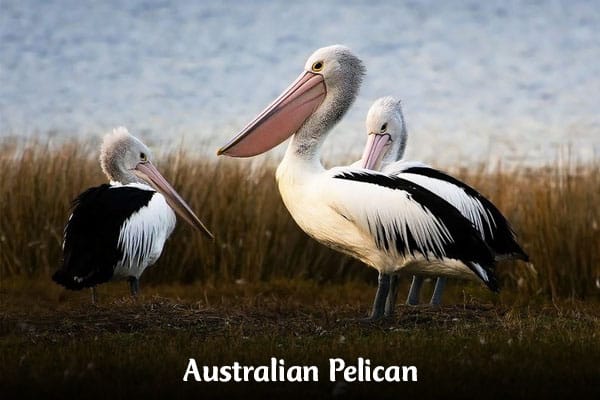
The Australian pelican’s massive bill can reach up to 50 centimeters long. This makes it the largest bill in the bird world. Its total length of 152–188 centimeters and the huge bill creates a unique look in the sky.
These pelicans are great hunters, eating fish, insects, and even small mammals. They’ve been known to eat silvergulls, small dogs, and other birds.
Their breeding habits are quite interesting. They lay one to four eggs, usually two. The eggs hatch after 32 to 35 days. Young pelicans leave the nest at three months and can live up to 25 years in the wild.
Despite their size and varied diet, the Australian pelican is considered a least-concern species. This shows how resilient and adaptable this bird is.
“Pelicans can stay in the air for 24 hours and travel hundreds of kilometers. They can fly as fast as 56 km/hour. Sometimes, a group of pelicans can have over 1,900 birds. They breed in large groups, sometimes with up to 40,000 birds.”
| Characteristic | Measurement |
|---|---|
| Wingspan | 2.3 to 2.6 meters |
| Weight | 4 to 13 kilograms (average 4.54 to 7.7 kilograms) |
| Bill Length | Up to 50 centimeters |
| Total Length | 152–188 centimeters |
| Incubation Period | 32 to 35 days |
| Fledging Age | Around 3 months |
| Lifespan | Up to 25 years or more |
2. Dalmatian Pelican
The Dalmatian pelican (Pelecanus crispus) is a huge bird, known for its size and presence. It is the largest freshwater bird in the world. This bird has many impressive features that make it stand out.
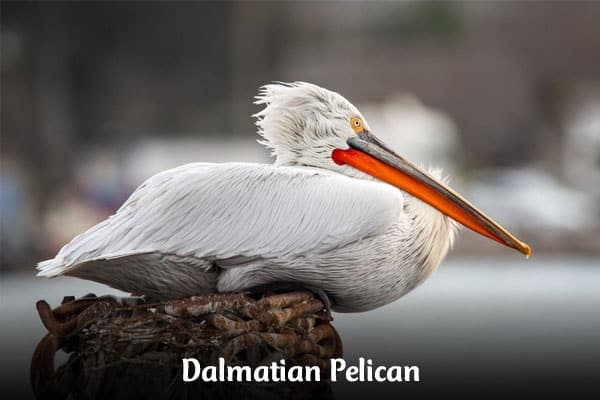
This bird has grey-white feathers, grey legs, and curly feathers on its neck. Its wings spread wide, from 8 to 12 feet, making it one of the biggest birds flying today. Its huge bill, 36 to 45 cm long, is among the biggest in the bird world.
The Dalmatian Pelecanidae is a natural wonder, weighing about 11.5 kg on average. The biggest males weigh around 10.4 kg, and females about 8.7 kg. These birds are known for their beautiful flight and how well they work together in groups.
| Characteristic | Measurement |
|---|---|
| Conservation Status | Near Threatened (IUCN 3.1) |
| Weight Range | 7.25–15 kg |
| Length Range | 160 to 183 cm |
| Wingspan Range | 245 to 351 cm |
| Median Weight | Around 11.5 kg |
| Largest Male Average | 10.4 kg |
| Largest Female Average | 8.7 kg |
| Median Adult Male Weight | 10.75 kg |
| Mean Estimated Body Mass | 10.9 kg |
The Dalmatian pelican is a true marvel of nature. It has a unique mix of features that make it a standout bird. Its size, wingspan, feathers, and how it eats make it a remarkable sight.
“The Dalmatian Pelican is the largest species of pelican, with a length of 5-6 feet and a weight of 16-34 pounds. Its wingspan ranges from 8-12 feet, making it the second-largest wingspan of any living bird.”
3. American White Pelican
American white pelican (Pelecanus erythrorhynchos) is a sight to behold. This large bird lives in the interior of North America. It moves to warmer areas in Central and South America when it’s cold.
It has bright white feathers, black wings, and an orange bill and eyes in the spring. The American white pelican is a true marvel of nature.

These birds have huge wings, up to 120 inches wide, and weigh 11 to 20 pounds. The oldest one lived 23 years and 6 months, showing how long they can live.
Unlike the brown pelican, they don’t dive for fish. They swim to catch fish like minnows and trout. They often hunt in groups and sometimes steal food from other birds.
They start breeding in early April or early June. Up to 5,000 pairs nest together. Both parents take turns sitting on the eggs for a month. The babies leave the nest after about 3 to 4 weeks.
They face threats from predators like foxes and birds of prey. But thanks to the Migratory Bird Treaty Act of 1918, they are not considered endangered. They are listed as Least Concern by the IUCN and Apparently Secure by NatureServe.
“The american white pelican is a true icon of the North American landscape, with its striking appearance and fascinating behaviors capturing the imagination of birdwatchers and nature enthusiasts alike.”
4. Brown Pelican
The brown pelican (Pelecanus occidentalis) is a fascinating seabird found along the coasts of the Americas. It is the smallest in the pelican family. These birds have a unique look and amazing hunting skills. They are a joy to watch.
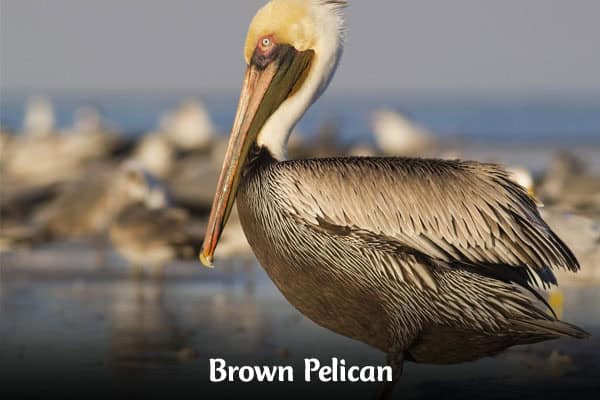
Physical Characteristics and Behavior
Adult brown Pelecanidae have gray-brown feathers, a yellow head, and a white neck. In the breeding season, their neck turns reddish-brown. They can grow up to 1.5 meters long and weigh 2 to 5 kilograms. Their big throat pouch is their best feature, used to catch fish in shallow waters.
These birds hunt by diving head-first into the water to catch fish. Young pelicans have brown feathers and a grayish bill. They live in large groups and can be seen on sandbars or beaches, cleaning themselves and socializing.
Once threatened by pesticides, the brown pelican has made a big comeback. Now, they are considered of Least Concern by the IUCN. These birds can live up to 43 years, showing their strength in coastal ecosystems.
| Characteristic | Description |
|---|---|
| Size | 1 to 1.5 meters in length, 2 to 5 kilograms in weight |
| Plumage | Gray-brown with yellow head and white neck, reddish-brown neck during breeding season |
| Feeding Behavior | Plunge-diving to catch schooling fish, using expandable throat pouch |
| Habitat | Coastal estuaries and marine environments |
| Conservation Status | Least Concern (IUCN) |
The brown pelican is a true wonder of the coastal world. Its unique look and behavior make it a favorite among bird lovers. As we learn more about these birds, we see how vital they are to their habitats.
5. Great White Pelican
The great white pelican (Pelecanus onocrotalus), also known as the rosy pelican, is a stunning bird. It lives in Asia, Africa, and southeastern Europe. These birds have huge wings, reaching from 226 to 360 cm wide. They love shallow lakes, swamps, and wetlands.
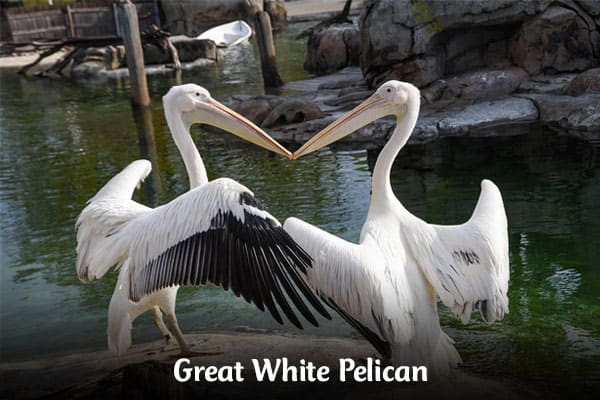
Their feathers are pure white, with pinkish legs and skin around their eyes. They eat fish and sometimes other small animals like birds, turtles, and tadpoles. They hunt together, swimming in circles to catch fish with their big pouches.
Conservation and Population Status
The great white pelican is not considered endangered, with about 75,000 breeding pairs worldwide, mostly in Africa. In Europe, over 4,000 pairs nest in Russia. They are protected by laws in Europe.
But, they face threats from people and nature, like wetland loss and pesticides. Foxes, gulls, and crows also threaten them. Protecting their homes and ways of life is key to their survival.
“The great white pelican is a magnificent sight, with its striking plumage and impressive wingspan. Watching these birds soar and hunt in coordinated groups is a true wonder of nature.”
6. Spot-billed Pelican
The spot-billed pelican (Pelecanus philippensis), also known as the grey pelican, is a fascinating bird. It belongs to the Pelecanidae family. These birds live in South Asia and Southeast Asia, in shallow, lowland freshwater areas. They nest in large groups on low trees.
This pelican is known for the spots on its upper bill. It has white feathers, a brown tail, and a grey crest and hindneck. Watching them glide over the water, hunting for fish, is amazing.
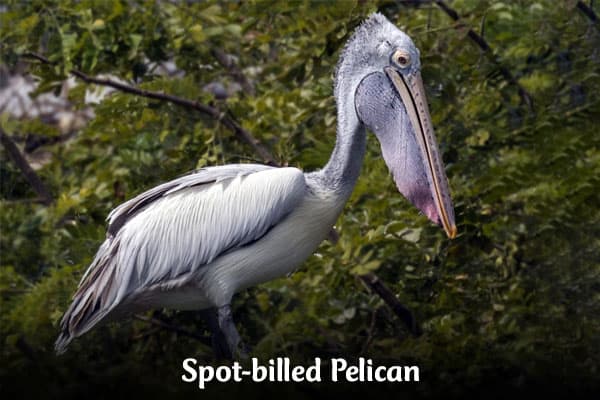
Despite their large size, the spot-billed pelican is listed as Near Threatened on the IUCN Red List. There are about 11,500 to 13,000 of them left. Their numbers are going down because of threats like nest disturbance, pollution, habitat loss, and fewer water bodies.
The success rate of these birds in making more pelicans varies a lot, from 25% to 75%. They usually have one brood a year, laying 3-4 eggs. After about 30 days, these eggs hatch. The young pelicans leave the nest after 60 to 90 days and become independent in about 12 weeks.
| Characteristic | Measurement |
|---|---|
| Body Length | 127 to 140 cm |
| Weight | Approximately 6 kg |
| Wingspan | 1.7 to 1.9 meters |
| Reproductive Success Rate | 25% to 75% |
| Population Estimate | 11,500 to 13,000 individuals |
| IUCN Red List Status | Near Threatened |
Learning more about the spot-billed pelican helps us understand its beauty and importance. We must work to protect this species in South and Southeast Asia.
7. Pink-backed Pelican
The pink-backed pelican (Pelecanus rufescens) is a unique bird in the Pelecanidae family. It lives mainly in Africa, southern India, and southern Arabia. It stands out with its grey-to-white feathers, yellow upper mandible, and greyish pouch.

In the breeding season, it changes looks with long feather plumes on its head. These Pelecanidae birds live in various water places like swamps, lakes, and floodplains. They eat fish and amphibians.
This pelican is smaller than others and nests in colonies. It picks low trees or reed beds near water. The pink-backed pelican is not threatened, so birdwatchers and nature lovers enjoy seeing it.
Biometrics and Habitat of the Pink-backed Pelican
The pink-backed Pelecanidae is big, measuring 125 to 155 cm long and with a wingspan of 2.15 to 2.9 m. It weighs between 4 to 7 kg and has a 30 to 38 cm long bill.
These pelicans live in many water places, like fresh and salty lakes, lagoons, and coastal waters. They sometimes visit extreme South Egypt, Morocco, the Canary Islands, and Israel.
Feeding and Behavior of the Pink-backed Pelican
This pelican is a great hunter, eating fish, small invertebrates, and amphibians. It can hold up to 8 liters of water and fish in its beak pouch.
Even though they’re big, they find takeoff hard. But once up in the air, they fly well, covering long distances with few wing beats.
Reproduction and Conservation Status
Pink-backed pelicans nest in large groups, with 20 to 500 pairs. They nest all year, and the eggs hatch after about 30 days.
This bird is not threatened globally, especially in sub-Saharan Africa. Its “Least Concern” status on the IUCN Red List shows it’s doing well and adapting well.
Related Articles
| Cockatoos in Australia |
| Hummingbird Tattoo Meaning |
| Owl Legs: Everything You Need To Know |
| Spiritual Meaning of Blue Jay Birds |
| Woodpeckers in Virginia |
8. Peruvian Pelican
The Peruvian pelican (Pelecanus thagus) is a unique bird in the Pelecanidae family. It’s known for its looks and where it lives. These birds live along the west coast of South America, from Ecuador and Peru to southern Chile. They love the cool waters of the Humboldt Current.
They look a bit like the brown pelican but are much bigger. They have dark grey-brown feathers and a white patch on their bill. This patch goes up to their crest and down their neck as stripes.
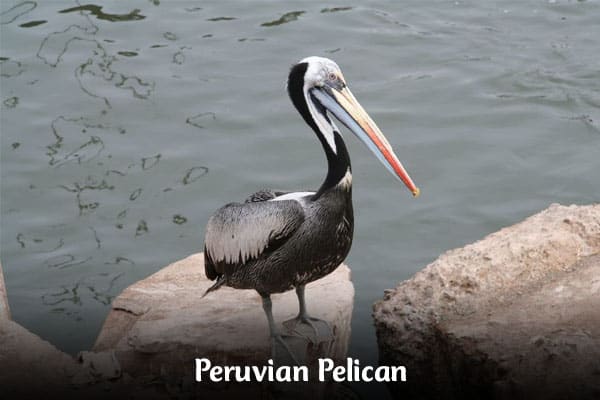
These Pelecanidae birds breed from September to March, laying two or three eggs. The eggs take about 4 to 5 weeks to hatch. The young birds stay with their parents for about 3 months before they leave the nest.
Unlike some other birds, Peruvian pelicans don’t dive deep to catch fish. They eat fish like anchovy, which they pick up from the water’s surface.
The number of Peruvian pelicans has been a concern lately. In 2008, they were listed as Near Threatened by the IUCN. By 2018, their numbers had grown, but they still face threats. These threats include competition with fishing and the impact of strong El Niño events.
Even with challenges, the Peruvian pelican is an amazing bird. It shows us how important the environment is for its survival. As we learn more about our world, the Peruvian pelican teaches us about nature’s strength and how it adapts.
Final Thoughts:
The pelican family (Pelecanidae) is a fascinating group of large water birds found all over the world. They include eight different species, split into two main groups. These birds are known for their big beaks and pouches that help them catch and drain water to eat.
Some pelicans are not considered endangered, but others have faced challenges like losing their homes and pollution. Yet, some species, like the Brown Pelican, have made a comeback after being endangered.
Pelecanidae are truly special birds that capture our interest with their unique features and actions. Learning more about them helps us value their diversity and importance in the bird world.

